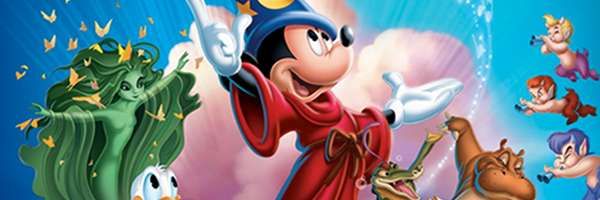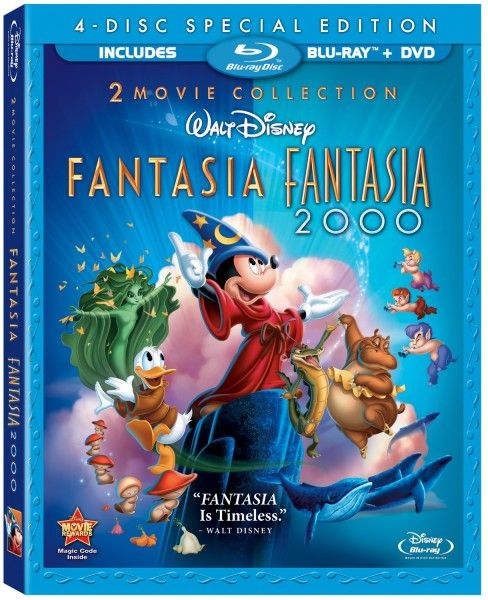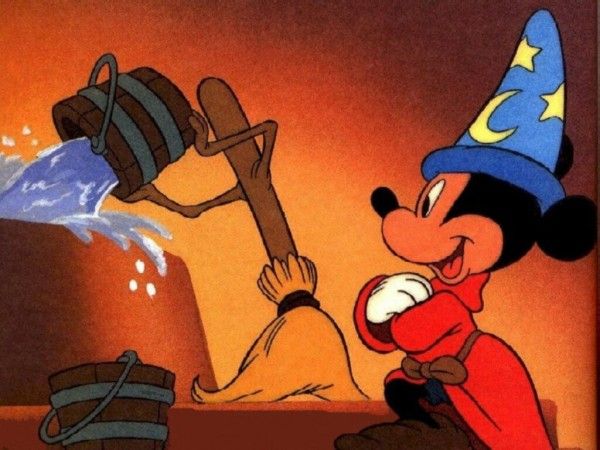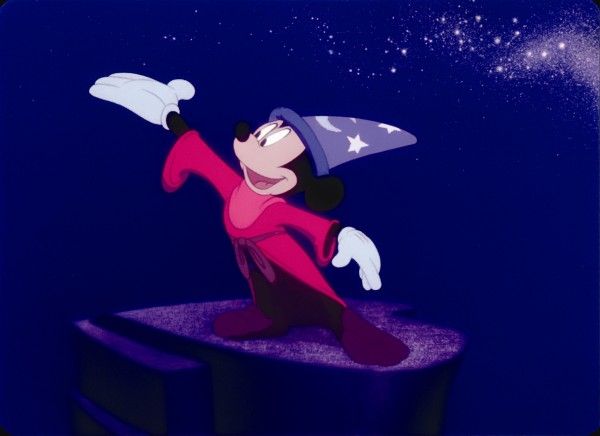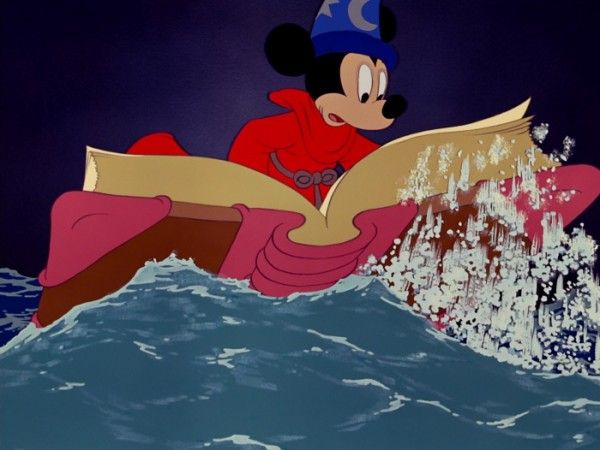Walt Disney’s Fantasia is many things. At first, it was a flop. Now – through Disney’s re-releases (and what appears to be a campaign selling the film to the drug addled in the 60’s) – it’s one of the top 25 highest grossing films of all time (adjusted). It’s a mainstream classic, but in structure it's also an art-house, experimental film. It’s singular - an omnibus, made of short, unconnected films that never build on each other - the majority of films like that have rarely worked. And though it’s been on home video for twenty years now, and it’s been available on DVD, Blu-ray gives us yet another chance to familiarize ourselves with Walt Disney’s passion project and absorb its brilliance and flaws. My review of the Fantasia/Fantasia 2000 double feature Blu-ray follows after the jump.
There are no stars in Fantasia. The leading performer is conductor Leopold Stokowski, who conducts the Philadelphia orchestra for the film. It’s seen as a concert movie, with Disney providing the animation for what might be imagined by its audience. Here it starts more experimentally, as notes are given color and shape. This is followed by The Nutcracker Suite, which features racist mushrooms (though a sambo character has been deleted from all DVD and Blu-ray versions). This is a more flowery look, with fish and plants and fairies dancing.
It is followed by what is the most revered section of the movie, The Sorcerer’s Apprentice, which also features Mickey Mouse in the cartoon that he is currently most recognized. Mickey tries to cheat at his work by using magic, but it backfires spectacularly. This is followed by The Rite of Spring, where the cosmos is explored, and the death of the dinosaurs comes to pass. Then comes an intermission, followed by Beethoven’s The Pastoral Symphony with mythical creatures playing and getting ready to date, and possibly breed. It is followed by “Dance of the Hours,” which has dancing ostriches, hippos and crocodiles, and the film ends with Night on Bald Mountain, which may very well be the most disturbing ten minutes of Disney’s entire oeuvre (which is saying something), but closes with Ave Maria.
Fantasia is more experience than film. There is no real narrative, and the majority of the pieces included do not have much of a story. Part of the reason why The Sorcerer’s Apprentice is the best remembered of the bunch is that it’s one of the only pieces that tell a proper narrative. To that sense, the film’s initial failure, and it’s relatively cold appeal are understandable. It doesn’t have the hooks of Bambi or Dumbo. And at a two hour plus running time, it’s easier to watch in a theater as a whole experience - while at home it’s better if it’s broken up into short films. In fact, if I were introducing a child to the film, I would spread each section out over days of watching, perhaps as a carton before a main feature.
As a whole, watching it front to back, it’s not very successful as a movie. But if you love animation and craft, the sound and vision is enthralling. The hand drawn animation is stunning to look at, and the animators only use the familiar Disney character designs with some of the pieces. But in Night at Bald Mountain, the animation and design work is singular, and the gorgeous imagery is as haunting as I remembered it from my childhood. Fantasia is a masterwork in its way, but not as much fun as its contemporaries. The recording of the orchestra is well persevered here in 7.1 DTS-HD Master audio. This is a showcase disc.
The film is presented in full frame (1.33:1) with the option of black bars on the side or DisneyView, which adds curtains, and color appropriate imagery on the side. It’s a peculiar retroactive pan and scanning, but it doesn’t change the ratio or anything like that, so it’s inoffensive. The film comes with three commentaries, two from the previous DVD release. The newest track is from Disney historian Brian Sibley, the second a clip track hosted by John Canemaker that collects audio interviews on the film, with the most important comments coming from Walt Disney. The third track comes from Roy E. Disney, conductor James Levine, Canemaker, and film restoration manager Scott MacQueen. The commentaries are the majority of the supplements. There’s a tour of the Disney Family Museum (4 min.), “The Schultheis Notebook: A Disney Treasure” (14 min.) a book that documented the making of the film. Then there’s an interactive art gallery with stills from both Fantasia and Fantasia 2000.
When the first film was released, the idea was that Disney would update it continuously. When the film failed that was scrapped, though reissues turned it into a classic. Fantasia 2000 is an amazing document, as it attempted to update the film by turning it into an Imax spectacle. In that way they were ahead of their time with the Imax stuff. This version is dated in different ways, with the most notable dating being the celebrity guest hosts, which include Quincy Jones, James Earl Jones, Penn and Teller, and Steve Martin. It starts with Beethoven’s Symphony No. 5 in the more experimental mode of the early goings of the first film, and then moves to Pines of Rome, which incorporates computer animation in a very transitional way. This leads into George Gershwin’s Rhapsody in Blue, which is done in the Al Hirschfield style. It’s fun, though the music cue is owned by Woody Allen.
It’s followed by an even more CGI influenced cartoon about a tin soldier done to Dmitri Shostakovich’s Piano Concerto No. 2, Allegro, Opus 102. This leads into a piece with a flamingo playing with a yo-yo set to Carnival of the Animals, Finale. This segues into The Sorcerer’s Apprentice, the only double dip. Donald Duck gets to appear in homage to Noah’s Ark for Pomp and Circumstance Marches 1, 2, 3 and 4, while the film wraps up with Angela Landsbury introducing Stranvisnky’s firebird Suite – 1919 version in a sequence that seems to be inspired partly by Hayao Miyazaki.
Fantasia 2000 remedies a number of the problems with the original. It has more stories that have a structure, and is mercifully short. Like the first film, what’s most engaging about the film is the craft, and perhaps more so now a decade on. Animation was in a transition period, and CGI was becoming more and more prevalent, so even though the film is looking at a digital future (and CGI is used throughout), there are so many great grace notes to the cel animation. Neither of these films works as films, but they do show two different versions of an animation studio with their craftsmen working at the height of their skills.
The film comes widescreen (1.78:1) and in 7.1 DTS-HD high resolution. Again, demo disc. Both films come with a DVD copy of the film. Extras here include both commentaries from the DVD release of the film, the first a track with Roy E. Disney, Levine, and producer Don Ernst, the second with the directors and art directors of the shorts. “Musicana” (9 min.) is about the making of the new film, and about some of the abandoned concepts for additional shorts. It’s followed by “Dali & Disney: A Date with Destino” (82 min.) a feature-length documentary about Disney and Salvador Dali’s attempts at collaboration, and the short film they almost made. It’s followed by the modern imagining of that short, “Destino” (6 min.). With a piece like this it is and isn’t what was intended, but is nothing less than fascinating. The disc also contains BD-Live content for the films in its “virtual vault.”

